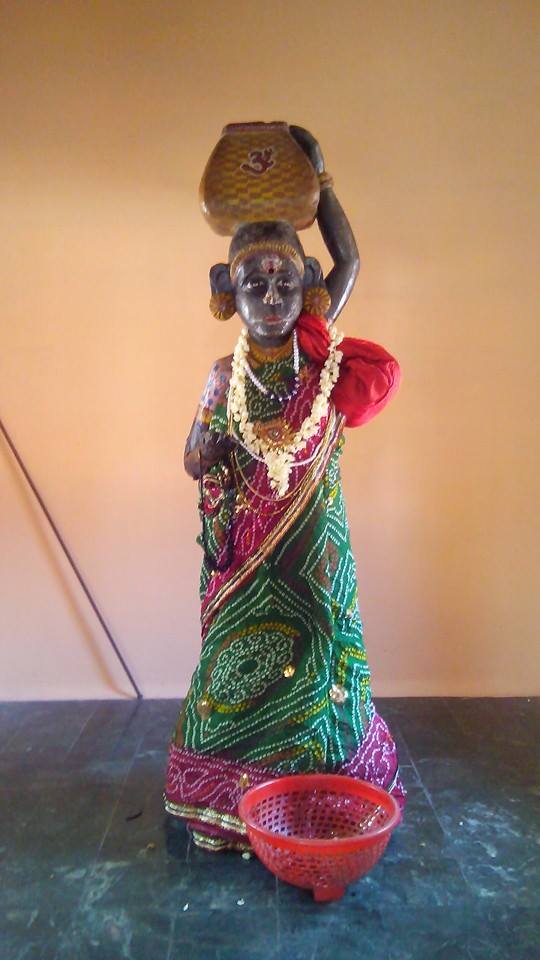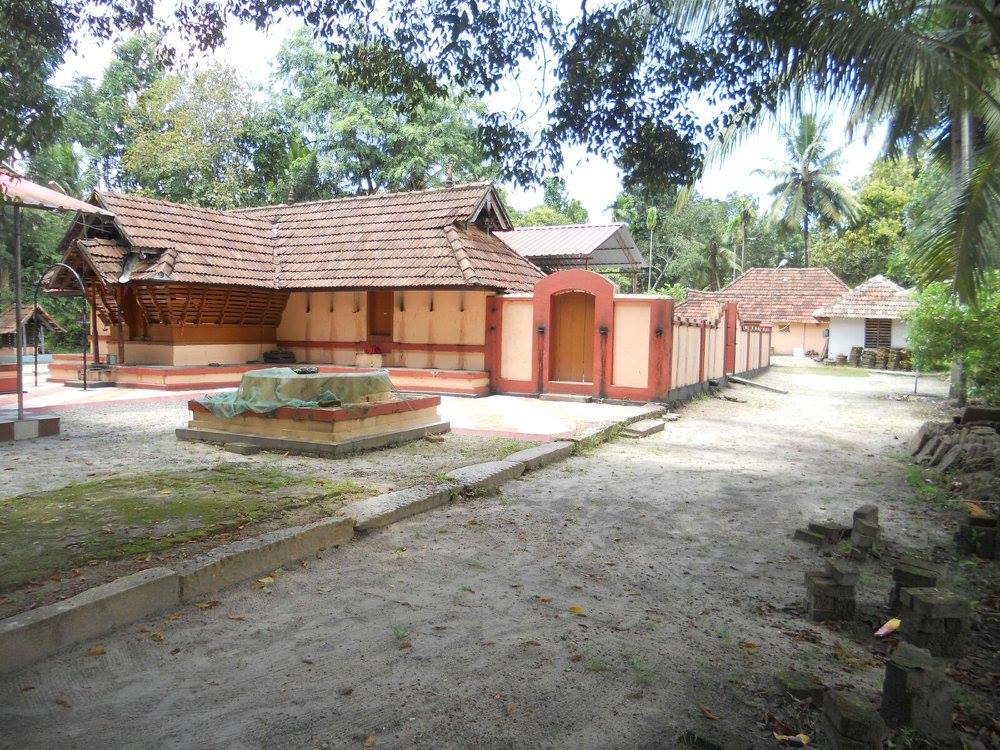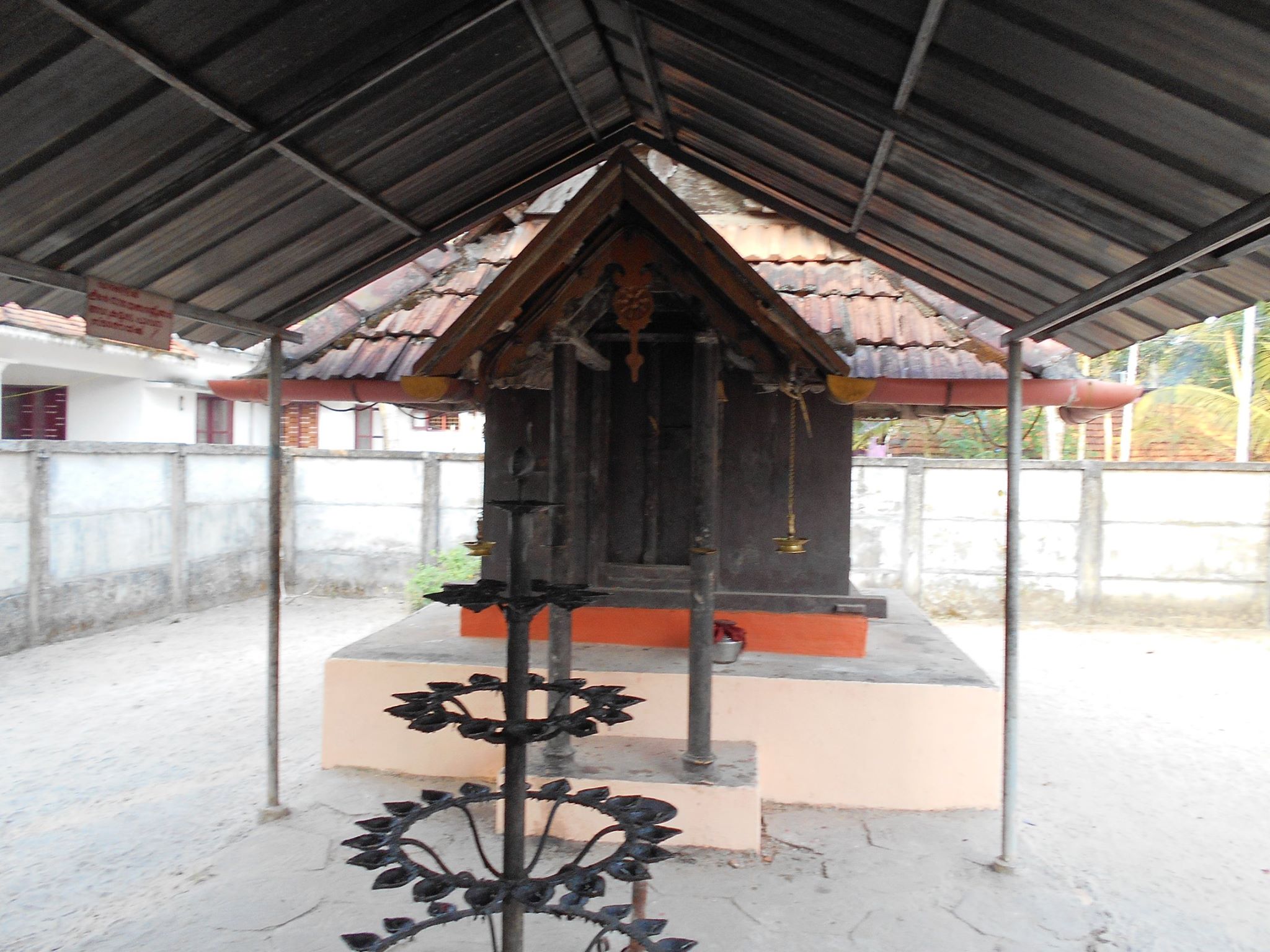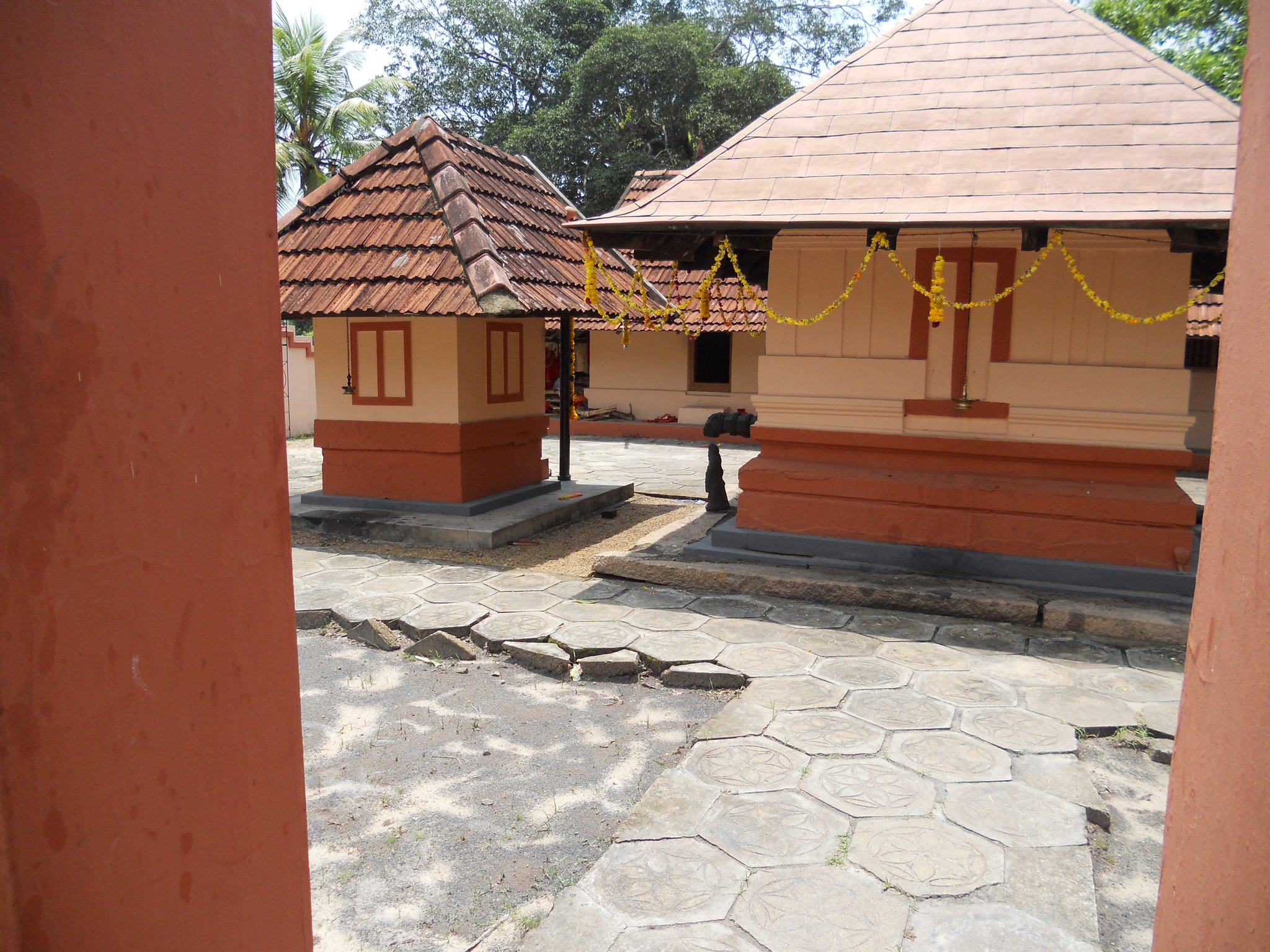Evoor Kannambally Devi Temple is accessible by a journey of 8.6 kilometers from Haripad to Nangyarkulangara in the Alappuzha district, following the Muttam route.

This temple is distinguished by its sub-goddess deity depicted in a pregnant form, a representation that is not found elsewhere in Kerala. In a single shrine, five deities are venerated.
Within the primary sanctum, located in the southwest corner, stone idols of Ganapati, Vishnu, Shastav, and Durga are enshrined. Additionally, the deity of Lord Shiva is positioned behind the goddess to the west, while the Yakshi deity is situated to the left of the goddess, both receiving equal reverence within the enclosure.
A well-known tale exists regarding the deity Kakatiyaamma. Long ago, in Changanassery, Kakathy became pregnant by a high-caste Jatan. To avoid shame, she was executed by being burned on a pyre of straw. An Antherjanam who witnessed this tragic event was also killed. The spirits of both individuals are said to have caused numerous misfortunes in the region. In Vazhapalli, the Karanavas, referred to as Valyachans of Tharavat, were known for their mastery of mantras.
It is believed that one of them summoned these spirits in a narayam and brought them to reside near the goddess. Historically, it is thought that only a Shiva temple existed in this area. At that time, Bhuvaneshwari Devi was the revered idol of a Brahmin family residing along the banks of Achankovilar in Kuttanad. Later Brahmins, mistaking Bhuvaneshwari for Bhadrakali, conducted pujas, which led to significant discontent and ultimately resulted in the alienation of the Brahmin family.
When the season arrived, Achankovilar experienced an overflow, causing water to enter the temple.
The idol of the goddess, crafted from Jacktree wood, was carried westward by the river and eventually reached the eastern side of the current temple site via Karipuzha Punja. Residents of a nearby house, known as Kavumthara, discovered the idol and mistakenly began using it as a wooden plank to sit upon. Over time, the house developed cracks, and upon investigation, it was revealed that the wooden plank was, in fact, the idol of the Goddess. The resident promptly informed Poti at Kannampalli, who visited the site, invited the Goddess using a copper sheet, and established her in his Math. Subsequently, under Poti's guidance, the idol was relocated slightly to the north, positioned in front of Shivanada, which is the current arrangement in the temple.
This temple features a sub-deity and allows visitors to enter and make offerings, a unique facility found in only one temple in Kerala. The temple festival occurs during the last three days of the mandala period, with significant ceremonies including Kalamezhuthu, Pattinkottu, Ezhunallip in old Thanga Jeevitha, Kapolichu Talapoli, and Guruti. The unique stone inscriptions discovered on the stepping stones of the temple well at Kannampalli provide evidence of the temple's ancient origins.
Located to the northeast of the temple, the Ilanji tree possesses numerous distinctive characteristics. Additionally, the Kayamkulam sword, which is approximately two and a half centuries old and was dedicated to the goddess by the King of Kayamkulam, is venerated within this temple. The thanga jivatha, dating back to the royal era, was constructed under the specific directives of the King of Kayamkulam. This temple is associated with the Vazhapallil family.
ഏവൂർ കണ്ണമ്പള്ളി ശ്രീദേവി ക്ഷേത്രം
ഈ ക്ഷേത്രം ഏകദേശം 1000 വർഷത്തിലധികം പഴക്കമുള്ളതാണെന്ന് വിശ്വസിക്കുന്നു. ഭഗവതി ഭുവനേശ്വരി എന്ന പേരിൽ അറിയപ്പെടുന്ന ദേവിയെ, പകൽ സമയത്ത് ശാന്തസ്വരൂപമായ ഭുവനേശ്വരിയായി കാണാൻ സാധിക്കും.
ഈ ശ്രീകോവിലിൽ അഞ്ച് പ്രതിഷ്ഠകൾ ഉണ്ട്. പ്രധാന ശ്രീകോവിലിന്റെ തെക്ക് പടിഞ്ഞാറേ കോണിൽ ഗണപതി, വിഷ്ണു, ശാസ്താവ്, ദുർഗ എന്നീ ദേവന്മാരുടെ ശിലാ വിഗ്രഹങ്ങൾ സ്ഥാപിച്ചിരിക്കുന്നു.
കൂടാതെ, ദേവിയുടെ പിൻഭാഗത്ത് പടിഞ്ഞാറ് ശിവന്റെ പ്രതിഷ്ഠയും, ദേവിയുടെ ഇടതുവശത്ത് ചുറ്റമ്പലത്തിനുള്ളിൽ തുല്യപ്രാധാന്യത്തോടെ യക്ഷിയുടെ പ്രതിഷ്ഠയും കാണാം.
കേരളത്തിൽ മറ്റൊരിടത്തും കാണാൻ സാധിക്കാത്ത ഗർഭിണി രൂപത്തിലുള്ള ഉപദേവതയായ കണ്ണമ്പള്ളി ദേവി ക്ഷേത്രത്തിന്റെ പ്രധാന ആകർഷണങ്ങളിലൊന്നാണ്. ഈ ഉപദേവിയെ കാക്കാത്തിയമ്മ എന്ന പേരിൽ അറിയപ്പെടുന്നു. ദൂരദേശങ്ങളിൽ നിന്നുള്ള ഭക്തജനങ്ങൾ പ്രതിഷ്ഠയെ കാണാനും വഴിപാടുകൾ നടത്താനും ക്ഷേത്രത്തിൽ എത്തുന്നു.
ക്ഷേത്രത്തിന്റെ നാലുമൂലയിലും വലിയ കാവുകൾ കാണപ്പെടുന്നു. ക്ഷേത്രത്തിനു മുന്നിൽ ഏകദേശം 100 അടിയോളം കിഴക്കുമാറിലാണ് കാക്കാത്തിയമ്മയുടെ പ്രതിഷ്ഠ സ്ഥിതി ചെയ്യുന്നത്. നാലടി ഉയരത്തിൽ പ്ലാവിൻ തടിയിലാണ് കാക്കാത്തിയമ്മയുടെ രൂപം. തലയിലെ വട്ടി ഇടതുകൈകൊണ്ട് താങ്ങി വലതുകൈ അല്പം നീട്ടിപ്പിടിച്ച ഗർഭിണിയായ സ്ത്രീയുടെ രൂപത്തിലാണ് കാക്കാത്തിയമ്മ നിലകൊള്ളുന്നത്. കാക്കാത്തിയമ്മയുടെ പ്രതിഷ്ഠയെക്കുറിച്ച് ഇവിടെ ഒരു പ്രചാരത്തിലുള്ള കഥ ഉണ്ട്.
അനേകം വർഷങ്ങൾക്കുമുമ്പ് ചങ്ങനാശ്ശേരി ഭാഗത്ത് കാക്കാത്തി ഒരു ഉന്നതകുല ജാതനിൽ നിന്നും ഗർഭം ധരിക്കുകയും, പിന്നീട് അപമാനം ഭയന്ന് ആ വീട്ടുകാർ കാക്കാത്തിയെ അപായപ്പെടുത്തി ഒരു വൈക്കോൽ തുറുവിലിട്ട് തീ കൊളുത്തി വധിക്കുകയും ചെയ്തു. ഈ സംഭവത്തിനു ദൃക്സാക്ഷിയായ ഒരു അന്തർജ്ജനവും വധിക്കപ്പെട്ടുവത്രെ. ഇവരുടെ ആത്മാക്കൾ ഒരുമിച്ച് ആ പ്രദേശത്ത് പല അനിഷ്ട സംഭവങ്ങൾ സൃഷ്ടിക്കുന്നു. വാഴപ്പള്ളിയിലെ തറവാട്ടിലെ വല്യച്ചന്മാർ എന്നറിയപ്പെടുന്ന കാരണവന്മാർ മന്ത്രസിദ്ധിയുള്ളവരായിരുന്നു.
അവരിൽ ഒരാൾ ഈ ആത്മാക്കളെ നാരായത്തിൽ ആഹ്വാനിച്ച് ദേവിയുടെ സമീപത്ത് താമസിപ്പിച്ചതായി വിശ്വസിക്കപ്പെടുന്നു.
ആദ്യകാലങ്ങളിൽ ഇവിടെ ശിവക്ഷേത്രം മാത്രമായിരുന്നു എന്നതാണ് പൊതുവായ വിശ്വാസം. അന്നത്തെ കാലത്ത് കുട്ടനാട്ടിൽ അച്ചന്കോവിലാറിന്റെ തീരത്ത് താമസിച്ചിരുന്ന ഒരു ബ്രാഹ്മണ കുടുംബത്തിന്റെ ആരാധനാമൂർത്തിയായിരുന്ന ഭുവനേശ്വരി ദേവി. പിന്നീട് വന്ന ബ്രാഹ്മണർ ഭുവനേശ്വരിയെ ഭദ്രകാളിയെന്നു തെറ്റിദ്ധരിച്ചു പൂജകൾ നടത്താൻ തുടങ്ങി.
ഇതോടെ പല അനിഷ്ട സംഭവങ്ങൾ ഉണ്ടാകുകയും, കാലക്രമേണ ബ്രാഹ്മണകുടുംബം ഇവിടെ നിന്ന് അന്യംനിന്നുപോകുകയും ചെയ്തു. അങ്ങനെയിരിക്കെ വര്ഷകാലമായപ്പോൾ അച്ചന്കോവിലാറിൽ കരകവിഞ്ഞു ഒഴുകി, ക്ഷേത്രത്തിൽ വെള്ളം കയറി. പ്ലാവിൻ തടികൊണ്ട് നിർമ്മിതമായ ദേവീവിഗ്രഹം നദിയിലൂടെ പടിഞ്ഞാറോട്ട് ഒഴുകി കരിപ്പുഴ പുഞ്ചയിൽകൂടി ഇപ്പോൾ ക്ഷേത്രം സ്ഥിതി ചെയ്യുന്ന സ്ഥലത്തിന്റെ കിഴക്കു ഭാഗത്ത് എത്തി.
പിന്നീട്, സമീപത്തുള്ള കാവുംതറ എന്ന ഭവനത്തിലെ താമസക്കാർ ദേവീ വിഗ്രഹം കണ്ടെത്തുകയും, അത് പ്ലാവിൻ തടിയാണെന്ന് തെറ്റിദ്ധരിച്ചു ഉപയോഗിക്കാൻ തുടങ്ങി. കാലക്രമേണ ആ വീട്ടിൽ അന്തച്ഛിദ്രങ്ങൾ ഉണ്ടാകാൻ തുടങ്ങി, പ്രശ്നങ്ങൾ ഉയർന്നപ്പോൾ, ആ പ്ലാവിൻതടി ദേവീ വിഗ്രഹമാണെന്ന് തിരിച്ചറിഞ്ഞു. ഉടൻ തന്നെ കണ്ണമ്പള്ളിൽ പോറ്റിയെ വിവരം അറിയിക്കുകയായിരുന്നു, അദ്ദേഹം അവിടെ എത്തി ദേവിയെ ഒരു ചെമ്പുകുടത്തിൽ ആവാഹിച്ച് തന്റെ മഠത്തിൽ കുടിയിരുത്തി.
പിന്നീട്, പോറ്റിയുടെ നേതൃത്വത്തിൽ സ്ഥാനം കണ്ടെത്തി, ശിവനടക്ക് മുൻപിൽ അല്പം വടക്കോട്ടുമാറി, പ്രത്യേകമായി പണികഴിപ്പിച്ച പഞ്ചലോഹ കണ്ണാടിബിംബത്തിലേക്ക് ദേവിയെ ആവാഹിച്ചു. ഈ ക്ഷേത്രം നടയ്ക്കുള്ളിൽ കയറി വഴിപാട് കഴിക്കാവുന്ന ഉപദേവതയെ സമർപ്പിച്ചിരിക്കുന്നു. കേരളത്തിൽ ഇത്തരത്തിലുള്ള സൗകര്യം ഉള്ള ഏക ക്ഷേത്രമാണിത്. ക്ഷേത്രത്തിലെ ഉത്സവം മണ്ഡലകാലത്തിന്റെ അവസാനത്തെ മൂന്ന് ദിവസങ്ങളിൽ നടത്തപ്പെടുന്നു.
കളമെഴുത്ത്, പാട്ടിൻകൊട്ട്, എതിരേൽപ്പ് (പഴക്കമേറിയ തങ്ക ജീവതത്തിൽ എഴുന്നള്ളിപ്പ്), കാപ്പൊലിച്ചു താലപ്പൊലി, ഗുരുതി എന്നിവ ആ ദിവസങ്ങളിൽ പ്രധാന ചടങ്ങുകളാണ്. കണ്ണമ്പള്ളിൽ സ്ഥിതിചെയ്യുന്ന ക്ഷേത്രകിണറിന്റെ ചവിട്ടുകല്ലിൽ കാണപ്പെടുന്ന അപൂർവ ശിലാലിഖിതങ്ങൾ, ഈ ക്ഷേത്രത്തിന്റെ പഴക്കത്തെക്കുറിച്ച് സൂചന നൽകുന്നു. ക്ഷേത്രത്തിന്റെ കിഴക്കു വടക്കായി സ്ഥിതിചെയ്യുന്ന ഇലഞ്ഞിമരം, പ്രത്യേകതകളാൽ സമ്പന്നമാണ്.
രണ്ടര നൂറ്റാണ്ടുകൾ പഴക്കമുള്ള കായംകുളം രാജാവ് ദേവിക്ക് സമർപ്പിച്ച കായംകുളം വാൾ ഈ ക്ഷേത്രത്തിൽ ആരാധിക്കപ്പെടുന്നു. രാജഭരണകാലത്ത് കായംകുളം രാജാവിന്റെ നിർദേശപ്രകാരം നിർമ്മിച്ച തങ്ക ജീവത, ക്ഷേത്രത്തിന്റെ ചരിത്രത്തിൽ ഒരു പ്രധാന പങ്ക് വഹിക്കുന്നു. വാഴപ്പള്ളിൽ കുടുംബത്തിന്റെ ഉടമസ്ഥതയിലുള്ള ഈ ക്ഷേത്രം, സമ്പന്നമായ പാരമ്പര്യത്തെ പ്രതിനിധീകരിക്കുന്നു.
Address:
Muttom, Kerala 690511



